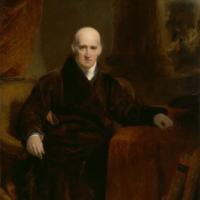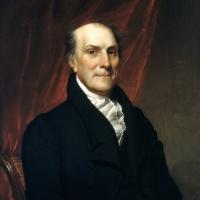Gilbert Stuart
Benjamin West
$480.00
Matthew Clarkson
$450.00
Gilbert Stuart
Gilbert Stuart (1755-1828)
Gilbert Charles Stuart (born Stewart; December 3, 1755 – July 9, 1828) was an American painter from Rhode Island who is widely considered one of America's foremost portraitists. His best known work is the unfinished portrait of George Washingtonthat is sometimes referred to as The Athenaeum, begun in 1796. Stuart retained the portrait and used it to paint 130 copies which he sold for $100 each. The image of George Washington featured in the painting has appeared on the United States one-dollar bill for more than a century and on various U.S. postage stamps of the 19th century and early 20th century.
Stuart produced portraits of more than 1,000 people, including the first six Presidents. His work can be found today at art museums throughout the United States and the United Kingdom, most notably the Metropolitan Museum of Art and Frick Collection in New York City, the National Gallery of Art in Washington, D.C., the National Portrait Gallery, London, Worcester Art Museum in Massachusetts, and the Museum of Fine Arts in Boston.
Gilbert Stuart was born on December 3, 1755 in Saunderstown, a village of North Kingstown in the Colony of Rhode Island and Providence Plantations, and he was baptized at Old Narragansett Church on April 11, 1756. He was the third child of Gilbert Stewart, a Scottish immigrant employed in the snuff-making industry, and Elizabeth Anthony Stewart, a member of a prominent land-owning family from Middletown, Rhode Island. Stuart's father owned the first snuff mill in America, which was located in the basement of the family homestead.
Stuart moved to Newport, Rhode Island at the age of six, where his father pursued work in the merchant field. In Newport, he first began to show great promise as a painter. In 1770, he made the acquaintance of Scottish artist Cosmo Alexander, a visitor to the colonies who made portraits of local patrons and who became a tutor to Stuart. Under the guidance of Alexander, Stuart painted the famous portrait Dr. Hunter's Spaniels when he was 14; it hangs today in the Hunter House Mansion in Newport.
In 1771, Stuart moved to Scotland with Alexander to finish his studies; however, Alexander died in Edinburgh one year later. Stuart tried to maintain a living and pursue his painting career, but to no avail, so he returned to Newport in 1773.
Stuart's prospects as a portraitist were jeopardized by the onset of the American Revolution and its social disruptions. He departed for England in 1775 following the example set by John Singleton Copley. He was unsuccessful at first in pursuit of his vocation, but he then became a protégé of Benjamin West with whom he studied for the next six years. The relationship was beneficial, with Stuart exhibiting at the Royal Academy as early as 1777.
By 1782, Stuart had met with success, largely due to acclaim for The Skater, a portrait of William Grant. It was Stuart's first full-length portrait and, according to art historian Margaret C. S. Christman, it "belied the prevailing opinion that Stuart 'made a tolerable likeness of a face, but as to the figure, he could not get below the fifth button'". Stuart said that he was "suddenly lifted into fame by a single picture".
At one point, the prices for his pictures were exceeded only by those of renowned English artists Joshua Reynolds and Thomas Gainsborough. Despite his many commissions, however, he was habitually neglectful of finances and was in danger of being sent to debtors' prison. In 1787, he fled to Dublin, Ireland where he painted and accumulated debt with equal vigor.
Stuart ended his 18-year stay in Britain and Ireland in 1793, leaving behind numerous unfinished paintings. He returned to the United States and settled briefly in New York City. In 1795, he moved to Germantown, Philadelphia where he opened a studio, and it was here that he gained a foothold in the art world and lasting fame with pictures of many important Americans.
Stuart painted George Washington in a series of iconic portraits, each of them leading to a demand for copies and keeping him busy and highly paid for years. The most famous and celebrated of these likenesses is known as The Athenaeum and is portrayed on the United States one-dollar bill. Stuart and his daughters painted a total of 130 reproductions of The Athenaeum. However, he never completed the original version; after finishing Washington's face, he kept the original version to make the copies. He sold up to 70 of his reproductions for a price of $100 each, but the original portrait was left unfinished at the time of his death in 1828. The painting was jointly purchased by the National Portrait Gallery and Museum of Fine Arts, Boston in 1980, and is generally on display in the National Portrait Gallery.
Another celebrated image of Washington is the Lansdowne portrait, a large portrait with one version hanging in the East Room of the White House. This painting was saved during the burning of Washington by British troops in the War of 1812 through the intervention of First Lady Dolley Madisonand Paul Jennings, one of President James Madison's slaves. Four versions of the portrait are attributed to Stuart, and additional copies were painted by other artists for display in U.S. government buildings. In 1803, Stuart opened a studio in Washington, D. C.
Stuart moved to Devonshire Street in Boston in 1805, continuing in both critical acclaim and financial troubles. He exhibited works locally at Doggett's Repository and Julien Hall. He was sought out for advice by other artists, such as John Trumbull, Thomas Sully, Washington Allston, and John Vanderlyn.
By the end of his career, Gilbert Stuart had painted the likenesses of more than 1,000 American political and social figures. He was praised for the vitality and naturalness of his portraits, and his subjects found his company agreeable.
Stuart was known for working without the aid of sketches, beginning directly upon the canvas, which was very unusual for the time period. His approach is suggested by the advice which he gave to his pupil Matthew Harris Jouett: "Never be sparing of colour, load your pictures, but keep your colours as separate as you can. No blending, tis destruction to clear & bea[u]tiful effect."
John Henri Isaac Browere created a life mask of Stuart around 1825. In 1940, the U.S. Post Office issued a series of postage stamps called the "Famous Americans Series" commemorating famous artists, authors, inventors, scientists, poets, educators, and musicians. Gilbert Stuart is found on the 1 cent issue in the artists category, along with James McNeil Whistler, Augustus Saint-Gaudens, Daniel Chester French, and Frederic Remington.
Today, Stuart's birthplace in Saunderstown, Rhode Island is open to the public as the Gilbert Stuart Birthplace and Museum. The museum consists of the original house where he was born, with copies of his paintings hanging throughout the house. The museum opened in 1930.
Gilbert Stuart's paintings of Washington, Jefferson, and others have served as models for dozens of U.S. postage stamps. Washington's image from the famous portrait The Athenaeum is probably the most noted example of Stuart's work on postage.




